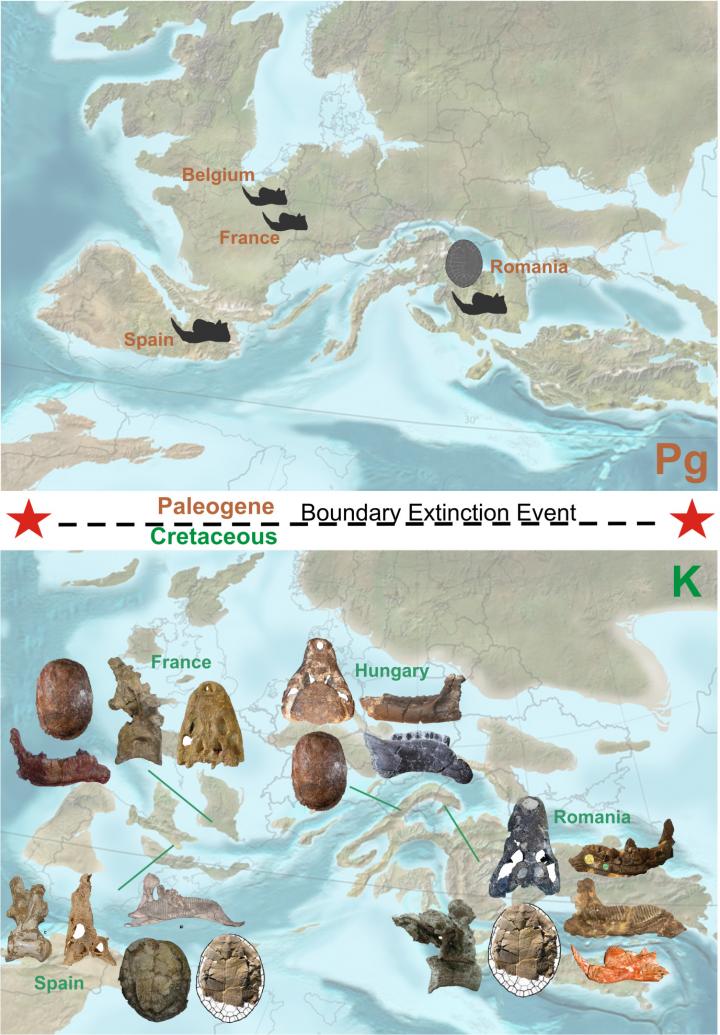Dinosaurs once flourished in Europe but when an asteroid hit 66 million years ago, they died quickly, according to a new study.
That an asteroid killed off the dinosaurs is widely held, but until recently dinosaur fossils from the late Cretaceous, the final period of dinosaur evolution, were almost exclusively found in North America. This raised questions about whether the sudden decline of dinosaurs in the American and Canadian west was merely a local story.
The new study synthesizes research on European dinosaurs over the past two decades. Fossils of late Cretaceous dinosaurs are now commonly discovered in Spain, France, Romania, and other countries.

A visual representation of the evolution of the European continental ecosystems across the Cretaceous-Paleogene Boundary Extinction Event: the diverse vertebrate assemblages of the latest Cretaceous, with dinosaurs, crocodiles, etc. Credit: Background paleogeography reconstructions - Dr. Ron Blakey, Professor Emeritus Northern Arizona University; fossils: Dr. Jeremy E. Martin (for other fossil image credits see the ZooKeys paper of Csiki-Sava et al
By looking at the variety and ages of these fossils, a team of researchers led by Zoltán Csiki-Sava of the University of Bucharest's Faculty of Geology and Geophysics has determined that dinosaurs remained diverse in European ecosystems very late into the Cretaceous.
In the Pyrenees of Spain and France, the best area in Europe for finding latest Cretaceous dinosaurs, meat and plant-eating species are present and seemingly flourishing during the final few hundred thousand years before the asteroid hit.
Dr Csiki-Sava said "For a long time, Europe was overshadowed by other continents when the understanding of the nature, composition and evolution of latest Cretaceous continental ecosystems was concerned. The last 25 years witnessed a huge effort across all Europe to improve our knowledge, and now we are on the brink of fathoming the significance of these new discoveries, and of the strange and new story they tell about life at the end of the Dinosaur Era."
Dr Steve Brusatte of the University of Edinburgh's School of GeoSciences (UK), an author on the report, added: "Everyone knows that an asteroid hit 66 million years ago and dinosaurs disappeared, but this story is mostly based on fossils from one part of the world, North America. We now know that European dinosaurs were thriving up to the asteroid impact, just like in North America. This is strong evidence that the asteroid really did kill off dinosaurs in their prime, all over the world at once."
The new study is published in the open access journal ZooKeys. It reviews the fossil record of Late Cretaceous land-living vertebrates (including dinosaurs) from Europe and provides the most up-to-date survey of how these animals were changing in the run up to the asteroid impact.
Other authors on the paper include leading European paleontologists Eric Buffetaut from the Centre National de la Recherche Scientifique in Paris (France), Attila ?si from the MTA-ELTE Lendület Dinosaur Research Group in Budapest (Hungary), and Xabier Pereda-Suberbiola from the Universidad del País Vasco/Euskal Herriko Unibertsitatea in Bilbao (Spain).
This work was supported by the National Research Council of Romania, University of Bucharest, Bakony Bauxite Mining Company, Hungarian Scientific Research Fund, National Geographic Society, Hungarian Natural History Museum, Eötvös Loránd University, Jurassic Foundation, Hantken Foundation, Ministerio de Economía y Competitividad of Spain, Gobierno Vasco/Eusko Jaurlaritza, National Science Foundation (USA), European Commission, American Museum of Natural History, and University of Edinburgh.
Citation: Csiki-Sava Z, Buffetaut E, si A, Pereda-Suberbiola X, Brusatte SL (2015) Island life in the Cretaceous - faunal composition, biogeography, evolution, and extinction of land-living vertebrates on the Late Cretaceous European archipelago. ZooKeys 469: 1-161. doi: 10.3897/zookeys.469.8439




Comments